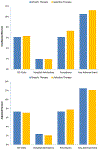Comparison of Selective Versus Empiric Pharmacologic Preventative Therapy With Kidney Stone Recurrence
- PMID: 33352163
- PMCID: PMC7940562
- DOI: 10.1016/j.urology.2020.11.054
Comparison of Selective Versus Empiric Pharmacologic Preventative Therapy With Kidney Stone Recurrence
Abstract
Objective: To assess the effectiveness of an empiric approach to metabolic stone prevention.
Methods: Using medical claims from a cohort of working age adults with kidney stone diagnoses (2008-2017), we identified the subset who were prescribed thiazides, alkali therapy, or allopurinol-collectively known as preventive pharmacologic therapy (PPT). We distinguished between those who had 24-hour urine testing prior to initiating PPT (selective therapy) from those without it (empiric therapy). We conducted a survival analysis for time to first recurrence for stone-related events, including ED visits, hospitalizations, and surgery, up to 2 years after initiating PPT.
Results: Of 10,125 patients identified, 2744 (27%) and 7381 (73%) received selective and empiric therapy, respectively. The overall frequency of any stone-related event was 11%, and this did not differ between the 2 groups on bivariate analysis (P = .29). After adjusting for sociodemographic factors, comorbidities, medication class, and adherence, there was no difference in the hazard of a stone-related event between the selective and empiric therapy groups (hazard ratio, 0.97; 95% confidence interval, 0.84-1.12). When considered individually, the frequency of ED visits, hospitalizations, and surgeries did not differ between groups. Greater adherence to PPT and older age were associated with a lower hazard of a stone-related event (both P < .05).
Conclusion: Compared to empiric therapy, PPT guided by 24-hour urine testing, on average, is not associated with a lower hazard of a stone-related event. These results suggest a need to identify kidney stone patients who benefit from 24-hour urine testing.
Copyright © 2020 Elsevier Inc. All rights reserved.
Figures
Comment in
-
EDITORIAL COMMENT.Urology. 2021 Mar;149:87-88. doi: 10.1016/j.urology.2020.11.055. Urology. 2021. PMID: 33678304 No abstract available.
References
Publication types
MeSH terms
Substances
Grants and funding
LinkOut - more resources
Full Text Sources
Other Literature Sources



